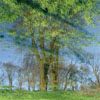 Floating silently through space approximately 1.4 billion km from Earth are the rings of Saturn. Composed primarily of ice particles, they appear as simple concentric circles similar to the grooves in a record. Thanks to the intricate play of moons, magnetic fields, and gravity, their structure is actually far more complex, fraught with braids and knots and unexpected waves of debris. Christoph Heemann's Rings also glide and ripple through the ether, but the space in which they float is both inner and outer, and closer to home than Saturn.
Floating silently through space approximately 1.4 billion km from Earth are the rings of Saturn. Composed primarily of ice particles, they appear as simple concentric circles similar to the grooves in a record. Thanks to the intricate play of moons, magnetic fields, and gravity, their structure is actually far more complex, fraught with braids and knots and unexpected waves of debris. Christoph Heemann's Rings also glide and ripple through the ether, but the space in which they float is both inner and outer, and closer to home than Saturn.
The Rings of Saturn gestated in Christoph Heemann's brain for 11 years before seeing the light of day, a fact attested by the many fragmentary samples and juxtaposed sounds that populate both its sides. Among the ambiguous wisps of drone and low-end swells are numerous environmental and musical recordings, which include the chiming of church bells and bird songs, a bass solo, a television game show theme, the bustle of a busy street, and even an aria. The latter, "Lascia ch'io pianga" from Handel's Rinaldo, appears early on the record and illuminates the design hiding within Heemann's seemingly disconnected edits.
Rinaldo is a patchwork opera, stitched together with songs and ideas Handel had written years before it was commissioned, yet it tells a coherent story and is celebrated among his greatest accomplishments. The Rings of Saturn has that same motley constitution, but it doesn't tell a story the way Rinaldo does; instead, it points toward philosophical and abstract concepts. In the buzz of lawnmowers and the barking of distant dogs Christoph uncovers the quiet moods and secret thoughts tucked away in the corners of the human psyche; he transforms universal sounds from public places into particular and private spaces within the folds of the mind.
Christoph doesn't just produce cinematic candy for the ears, he replicates places, and all the thoughts and ideas that come with them; he finds the locations where personal and public experiences meet and then he straddles that line and dwells there, meditating on the richness of their collision. Thanks to a stellar mixing job, he even captures the wind blowing the trees and the fading buzz of cars rumbling distantly down the road, among numerous other small sounds, each of which further the sensation of worldly and psychological immersion characteristic of the entire record. It's important to keep the volume up in order to catch all the little details. Doing so makes the immersion that much more convincing, and it helps the marching band Heemann recorded boom and blow the way it would were it really passing by on the street.
Field recordings provide the essential gravity for Rings, but processed audio like the kind both Mirror and H.N.A.S. have produced resound prominently in the mix as well. The most striking examples appear in the second and fifth pieces; the former is an icy and elegant bass solo accompanied by glistening synthetic waves and the latter is a monumental wash of glacial bellows and metallic whirls. Amidst these secluded sounds and communal happenings are comedic morsels of audio and bizarre shards of sound bent psychedelically into fun-house shapes. These studio recordings both mimic and cut up the quiet, mental density of Heemann's environmental ambience, but they also emphasize collage as Heemann's primary technique.
On The Rings of Saturn, that technique is refined and tempered into perfect shape. By blurring his many penchants together and submitting them to subtle edits, he has produced one of the very best records released under his given name. It is easily his most listenable and enjoyable album since the Lebenserinnerungen Eines Lepidopterologen collection, but it also feels more substantial and considerate. Still, the elegant weightlessness of its character, the way it hovers quietly through a room, is perhaps its greatest virtue. That might also be the reason Christoph decided to name these recordings after the halo around Saturn. Besides their shared beauty, both orbit a massive hub, which is remote and mysterious. One hub is shrouded in violent gas storms and the cold of space, the other by skin and bones. Heemann teases out the contents of the latter, and what he finds is immensely beautiful.
samples:
 
Read More

